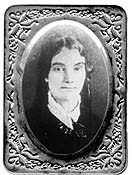This is the first part of a three-part series on Women in Wisconsin Law.
 Throughout Wisconsin’s history, women have played an instrumental role in the development of the state’s legal system. Among these women was Lavinia Goodell of Janesville, the first woman admitted to practice law in Wisconsin.
Throughout Wisconsin’s history, women have played an instrumental role in the development of the state’s legal system. Among these women was Lavinia Goodell of Janesville, the first woman admitted to practice law in Wisconsin.
Before her move to Wisconsin, Goodell worked as an editor for several newspapers in New York. During this time, Goodell confided in a coworker that her life’s ambition was to become a lawyer. When Goodell’s parents retired to Janesville, Wisconsin, in 1871, she was convinced into joining them with her father’s promise that she would be able to study law. Upon arriving in Wisconsin, Goodell’s father helped his daughter find attorneys who would permit her to study law alongside them through an apprenticeship. After demonstrating her ability to successfully practice law as an apprentice, Goodell sought admission before the local circuit court and, with the support of several prominent local lawyers, was admitted to practice in the Circuit Court of Rock County, Wisconsin, in 1874.
After being admitted to practice law at this local level, Goodell opened her own law office that primarily represented woman and the elderly. Despite being able to practice at this local level without much difficulty, one of Goodell’s cases in 1875 was appealed to the Wisconsin Supreme Court. When the supreme court did not allow her to argue the case, Goodell filed an application for state admission.
A formal hearing was held in front of the supreme court on December 14, 1875. The court was comprised of three men, led by Chief Justice Edward Ryan, a man known for his vocal opposition to women’s rights. Despite Goodell’s best arguments, the Wisconsin Supreme Court denied her petition for admission to the bar in February 1876. Following the court’s decision, Goodell’s campaign for admission gained support from a variety of groups, including local press and prominent, local lawyers.
Goodell’s quest to be admitted to the Wisconsin bar was finally achieved in 1879. After the election of John Cassody, one of Goodell’s supporters from Janesville, to the position of speaker of the Wisconsin Assembly, a bill was quickly introduced to secure the right of admission for women. Following the passage of this new legislation, Goodell renewed her application to the Supreme Court. On June 18, 1879, Judge Orsamus Cole admitted Lavinia Goodell to the Wisconsin bar. Following Goodell’s admission to the bar, several other women were admitted. However, women would not play a significant role in the state bar until years later.
Goodell continued running her law firm in Janesville until her untimely death in 1880 at the age of forty-one. Although her time practicing before the state courts was cut short by her young death, it is undeniable that her dedication to gaining admission to the bar paved the way for generations of future women lawyers to be formally admitted to practice law in Wisconsin.
A special thank you to Joseph A. Ranney for encouraging my interest in Wisconsin legal history and providing guidance for selecting prominent Wisconsin women to highlight in this series.
Sources:
Joseph A. Ranney, Trusting Nothing To Providence: A History of Wisconsin’s Legal System (1999).
Karen Berger Morello, The Invisible Bar: The Woman Lawyer in America 1638 to the Present (1968).
Catherine B. Cleary, Lavinia Goodell, First Woman Lawyer in Wisconsin, 74 Wisconsin Magazine of History 243 (Summer 1991).
In re Goodell, 39 Wis. 232 (1875).
